I saw Donn Draeger for the first time when I was 13 years old–the year was 1969, if I remember correctly. My father had heard that some top ranked martial artists from Japan were coming to Bethesda, Maryland to give a demonstration. Since my father, my older brother and myself were all exponents of Kodenkan Jujutsu, we were all looking forward to seeing this demonstration.
All I really remember of the demo was an old Japanese man (Shimizu Takaji) and a big Caucasian (Donn F. Draeger), who was wielding a strange looking weapon called a kusarigama (a sickle with a weighted chain), which fascinated me. I had no idea who these men were besides experts from Japan. This was one of the first times both classical budo and bujutsu were shown outside of Japan. I wasn’t aware of it at the time, but I saw Shindo Muso-ryu jodo, and Katori Shinto-ryu demonstrated for the first time in Maryland.
Donn Draeger and Shimizu Takaji – Isshin-ryu Kusarigamajutsu
I later obtained Draeger and Smith’s book Comprehensive Asian Fighting Arts. This book was amazing to me. All these styles and systems from all over the world looked so interesting! I wanted to learn them all.
My next encounter with Donn Draeger occurred in 1974, at the age of 18. I had just graduated from high school, and I had the opportunity to travel to Japan. My father suggested that I write to Donn since he was based in Tokyo. I sent a letter to him in care of his publisher, having no idea if the letter would even get to him. A couple of months before I left, I received a polite response from him: “Your letter has finally sifted down to me from my publisher. What did you have in mind? I await your reply.” Signed, Donn F. Draeger.
I immediately returned a letter stating my intention to go to Japan to study the martial arts. In his reply, he told me that he would help me in any way that he could. He wrote: “Keep in mind that what you are doing in the U.S. is probably very different from the way things are done in Japan. All you have to do is keep an open mind, and let the Japanese show you their art.” He told me that he would be doing research in Borneo when I arrived in Japan, but he gave me the number of Howard Alexander to contact when I arrived.
I arrived in Japan, contacted Howard and was taken to the Rembukan dojo, where Shindo Muso-ryu jodo was taught as a koryu, with Shimizu Takaji as the headmaster. At the time, I did not make the connection that this was the same man I had seen demonstrate with Donn five years earlier in Maryland.
I trained in jodo for about three months before I heard Donn was back from Borneo and would be back the next week. Someone mentioned to me, “When he takes off his shirt, you won’t believe it. Even at age 53, his muscle development is awesome.” They were right. Donn showed up, peeled off his shirt to get into his keiko gi ,and I am sure my mouth fell open.
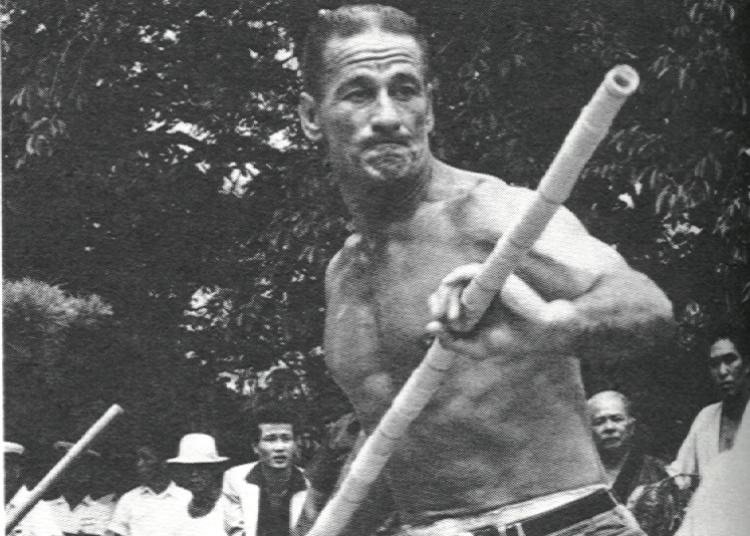
Donn Draeger on the set of YOU ONLY LIVE TWICE
As we trained together, I was impressed at how this big strong guy moved so smoothly with power. He always provided just the right amount of resistance for me. He didn’t overpower me, but he didn’t give it away either. He made me work, but the work was efficient. After the training session ended, I introduced myself and told him I was the guy who wrote him from California. He smiled and said that he was glad that I had indeed come to Japan and was studying jodo. As practice ended, I saw Donn and Shimizu sensei together side-by-side, and I finally made the connection. blurted out “Hey! I know you guys! You were both at the demonstration I saw in Maryland in 1969!” They both got a smile on their faces from that one.
Another funny incident that happened at the dojo was also at the end of a training session. Several of the guys who trained at the dojo were into health food, such as brown rice, and were vegetarians. Donn took off his gi (muscles rippling), put on his street clothes and looked around at the people in the dojo. He smiled and said, “All right, who is ready for some garbage?” We all got on a bus and headed out for pizza.
I trained with Donn at the dojo several times, and afterwards, listened to stories from his latest expedition. I heard about a tussle he had with a ‘combat taijiquan’ man, Lee Pit Lai (Lee Bei Lei), whom he called “The Butcher.” Apparently, the taiji butcher started to push Donn, so he responded with a foot sweep that unbalanced him and got his attention. I heard later that the two of them ended up in another skirmish that knocked a sink off the wall. The thing I most remember, though, was that I was unable to really look at his eyes. His whole presence was very intense, and I counted myself lucky to just ride on the same bus with him
In May of 1975, I left Japan after nine months of training in jodo and aikido to return to Los Angeles for my university education at UCLA. It was at that time that Donn first told me about hoplology, stating “Its development will need young men like yourself.” I told him I was interested and that I would write to him when I returned to L.A.
I corresponded with Donn over the next five years, either asking questions about hoplology or helping him with his courses at the University of Hawaii by writing letters of interest to the appropriate departments. In 1979 I received an invitation to attend the First International Jodo Jamboree, to be held in Malaysia. I imagined that I would be at the end of a crowded football field filled with martial artists from all over the world. I was sure that I would barely be able to see him, but I was also sure that I wanted to go to this Jodo camp. I wrote to Donn that I wanted to attend and told him of the travel plans I would make to get to Malaysia. He wrote back that if I wanted, I could come to Japan instead and “travel the cheap way like I do. We will fly to Thailand and then take the 25 hr. train ride from Bangkok to Penang, Malaysia.” This immediately became a ‘must trip.’
In July of 1979, Donn met me at Narita airport. This time I was able to look him in the eyes. He knew I was there because of my interest in judo and hoplology. We had dinner and I conked out in one of the two rooms of his small Japanese apartment. He had no heater and no air conditioner. He trained in Katori Shinto-ryu every day, and walked six to eight miles a day. He did not smoke, drink alcohol, or even coffee: not because of any hang-ups–he just didn’t like what they did to him. He said that he liked the waterproof and floatable camera I brought him, but what he really liked were the homemade chocolate chip cookies (from my mom)!
I woke up early, and looked through some of his books as well as a lot of photographs from previous expeditions. He told me that he was working on a two-volume book about Penjtak Silat of Malaysia and Indonesia. He said that it would go into much more depth than the other book he had written on Pentjak Silat with Howard Alexander and Quintin Chambers
Donn took me to a hospital in Tokyo to visit with Watatani Kiyoshi sensei. Watatani was probably the most knowledgeable budo historian living at that time. He had completed the Bugei Ryuha Daijiten, a 900-page book delineating over 10,000 ryuha. Watatani was very ill, and Donn was afraid it would be the last time he might see him. Watatani sensei was sitting up in bed cross-legged, and his eyes lit up like a little kid when he saw Donn walk in. He really made his day!
After two days in Japan, we flew to Bangkok and boarded a train for a twenty-five hour trip to Butterworth, Malaysia. It was just the two of us, and I took the opportunity to interview him about hoplology. I had a list of twenty-eight questions and I asked him if he minded answering some. “Fire away,” he said. I made notes on the topics he covered: the macro-analysis of a weapon and a system; the typology and descriptions, the group, genus, type and subtype of weapons and systems. Then he gave me a field notebook and told me to memorize as many weapons and names as possible, because we would be seeing many on this trip.
We also discussed the ‘four objectives’ of a system:
- Shiai – Competition
- Goshin – Self Defense
- Satori – Enlightenment
- Shobu– Killing/Lethal
Donn made it clear that you can really have just one objective. One of the four. If you claim to have more than one of them, you end up with none. We talked about fear, confidence, experience and fudoshin (immovable mind). He said that knowing yourself is a product of proper training under a qualified teacher for a protracted length of time.
The head of Malaysian Jodo, Karunakaran,a student and friend of Donn’s for many years, met us at the train station in Butterworth. We had dinner and got situated, and the next day we were off to Taiping to begin the Jodo Jamboree. There were representatives from Switzerland, New Zealand, Japan, Malaysia, Singapore. I was the sole representative of the United States that year.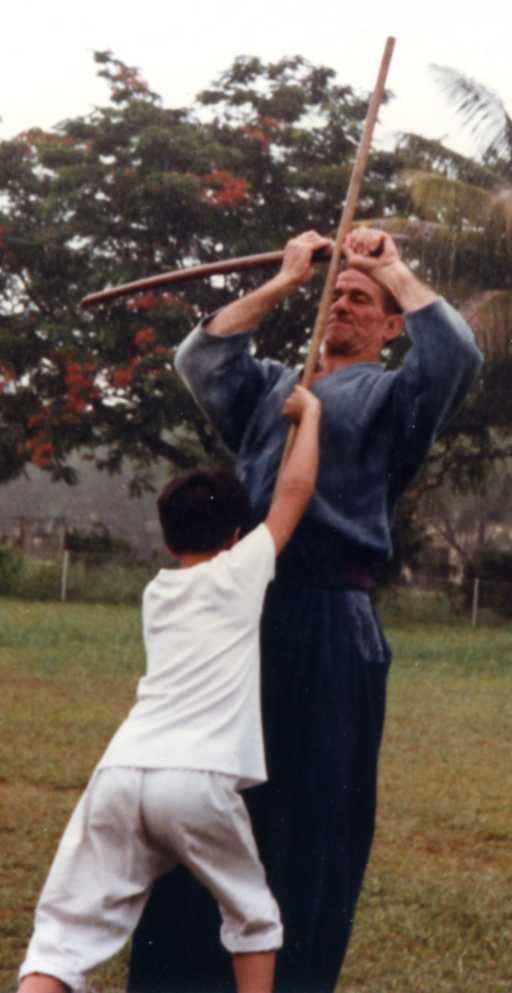
Training at the five-day camp consisted of three training sessions a day, plus a lecture, and then some evening event, such as a demonstration from local martial artists. My concentration was in the omote or first level of the jodo curriculum. I met many great people during the camp, and I saw how Donn trained the instructors as well as beginners. He met each of us at our own level and then pushed us just a little farther then we thought we could go. The day before rank testing, he told me I would be tested for my sankyu rank. Everyone else had been preparing for the test for days. I heard later that one of the things Shimizu sensei would do to Donn was change the kata he was going to present on the day of the demonstration! “Be prepared at all times,” was his message to me.
After the camp, Donn took me to see several master teachers, so I could observe their styles and training methods. We visited:
- P’ng Chye Khim of Saolim.
- Master Cheong Cheng Leong and Master Tan of the Phoenix Eye Fist
- Master Rahman of Silat Seni Gyung
- Master Lee Pit Lai AKA Lee Bei Lei (The Butcher) of Combat Taijiquan
- Master Abananthan of Indian Silambam
(NOTE: a fine book on the milieu of Chinese martial arts in Malaysia in the late 20th century is Nigel Sutton’s, Searching for the Way (Sutton became a student of Lee Bei Lei and in his books, describes this formidable man in detail).
Throughout my life, I have looked for guidance and direction. I formally requested that Donn become my teacher, and made the decision to follow him and what he had to teach. I think the happiest day of my life was when Donn accepted me as one of his personal students. He simply signed his reply to me as “Your Sensei.” Here was a man who impressed me enough with his style, his interests and his ethics to follow him, and I was willing to make whatever adjustments that were necessary in my personal life that were necessary. I made a promise to myself that within three years, I would return to participate in the three month expedition that Donn made each year to continue his hoplological research, and train new hoplologists out in the field. My interest in hoplology was ignited, and I was looking forward to more ‘travels with Donn Draeger.’
I returned to Los Angeles. I found out four months later that the whole team that left with Donn was poisoned in Sumatra by an Aceh tribe. The entire team had severe intestinal problems, and were all on antibiotics. The rest of the team recovered, but I suppose this was the turning point for Donn’s health. Things went downhill from there.
Donn Draeger taught me many things besides technique. He taught me to always go as close as possible to the source of knowledge, whether it be a country, a system, a book, or a person. He taught me to know what I was doing, to look inward and not fool myself. He taught me to keep an open mind and let people show who they are by their actions. Donn Draeger gave to all of us: time, energy, money, knowledge and patience. All anyone would have to do to be accepted by him is have an open mind and be willing to work. What he did for me was special. But what is really special, is that he had this same effect on hundreds of people. His standard operating procedure was to share his knowledge and experience.
The last time I saw my sensei alive was in Hawaii in 1980. We trained in jodo. I have a great photograph of him looking strong and ready to go, even though I knew he was in a lot of pain at the time. He seemed to be saying “I am ready. Are you?”
Podcast with Michael Belzer, going into more detail on this and other subjects
Addendum
Donn Draeger worked for many years with Mr. Richard Hayes on a magnum opus concerning ‘the theories of hoplology.’ It was never completed. However, the outcome of their dialogue can be found in Hayes’ “Paleolithic Adaptive Traits and the Fighting Man,” published by the International Hoplology Society. This was followed up by Hunter Armstrong’s “The Two Faces of Combatives,” an excellent integration of all of the material that Draeger and Hayes were working on.
Donn Draeger and Wally Lamb, judo, 1956
During these years, I functioned as an amanuensis, compiling their correspondence, and participating in the dialogue as well. After Donn’s death, Hayes set about re-writing (by hand) everything he wrote to Donn. As I received each letter, I highlighted various topics in a color code. After ten letters (there were hundreds), I would take them to a secretary to type them up, category by category. I would mail them back to Hayes–he would edit them some more, and send back to me. We went back and forth until we finally created the “Conceptual Tools for the Hoplologist.” (unpublished).
Tenshin Shoden Katori Shinto-ryu iaijutsu
During this process, Mr. Hayes sent me six audio tapes from Donn. There, he discussed various aspects of the theoretics they were developing. However, he also talked about various aspects of his own life. Since he was ordinarily such a private person, this is a rare opportunity to hear the man I personally knew. I edited out the didactic portions and created a new tape entitled, “Donn Draeger Speaks – To You.” I tried to re-create the experience I had on my twenty-five hour train ride with him so many decades ago.
Tenshin Shoden Katori Shinto-ryu iaijutsu
I then created a power point presentation, adding photos and video clips to the edited audio tape. I call it “The Life of Donn Draeger and His Impact on the Martial Arts”. If anyone is curious about this presentation, you are welcome to contact me.
Finally, I’ve no doubt that this article will evoke questions as to what ever happened to Donn Draeger’s biography, started several decades ago. To the best of my knowledge, it is still an ongoing project, but it is in limbo status, due to the professional responsibilities of the author.
NOTE: Due to the way this wordpress template works, some captions could not be inputted without them going across the photograph. For those interested:
4. Draeger & Shimizu – Okuden: Shindo Muso-ryu
5/7/8. Donn Draeger and the author, Michael Belzer
No part of this material may be reproduced in any form or by any means, electronic or mechanical, including photocopy, without permission in writing from the author. However, you are welcome to share a link to this article on such social media as Facebook, LinkedIn or Twitter.

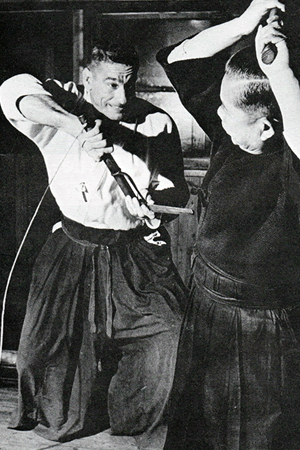
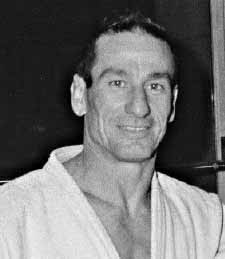
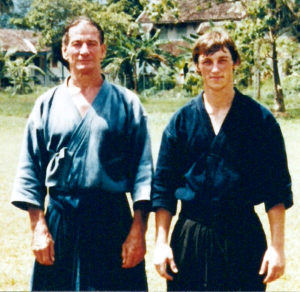
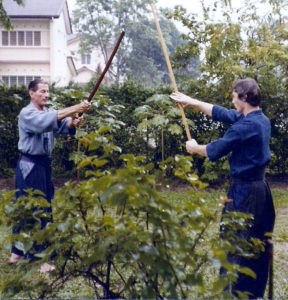
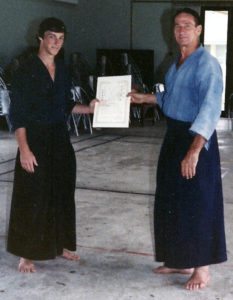
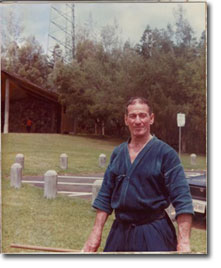
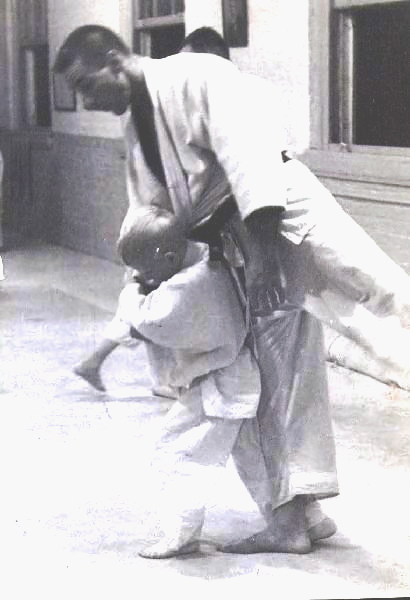
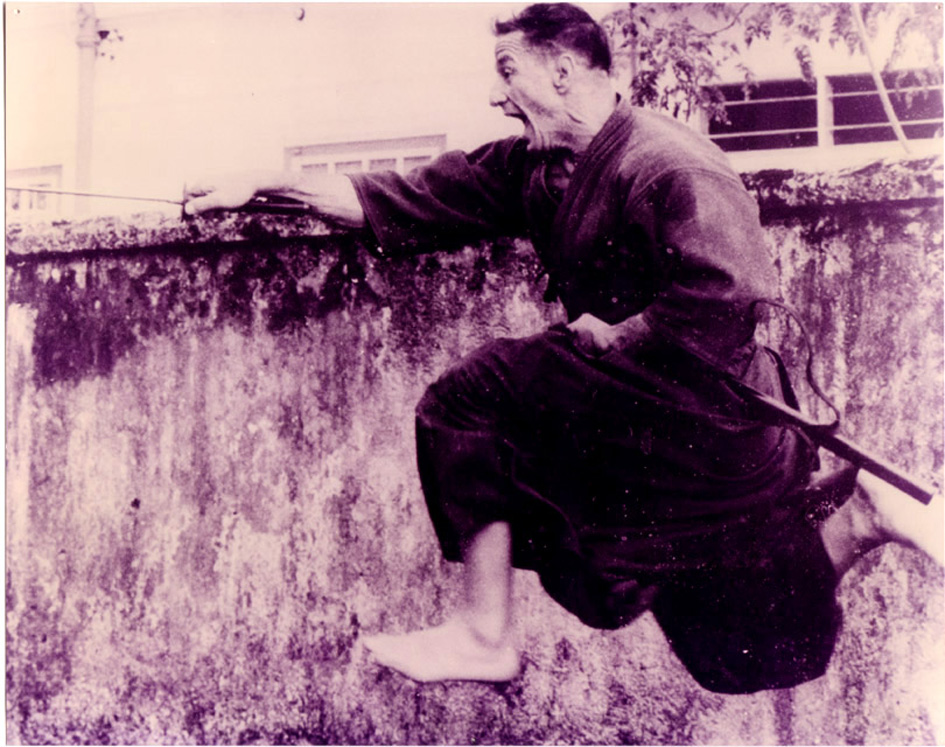
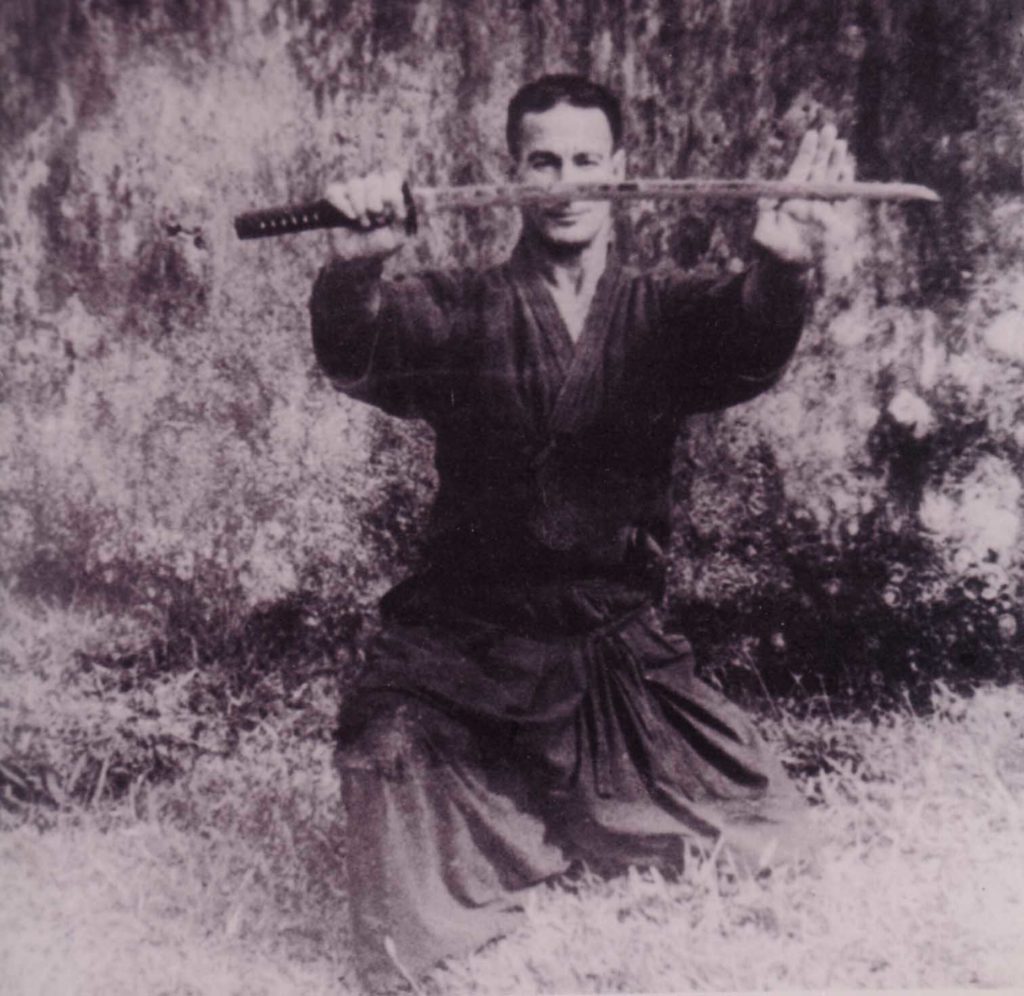
Richard Ingate
Really lovely article, especially for us ‘older’ students of the art. I suspect I met ‘The Butcher’ during my time in Malaysia and was ignominiously thrown head over heels on to a bed by one of his students in a hotel room in somewhere in Johor!
Rick Matz
Great post! Thanks for sharing.
dan docherty
This is excellent and very inspiring. Young guys sometimes need a mentor – you got one of the best.
Robert Noha
Hi Michael,
Thank you for the terrific post. I never met Draeger Sensei, but I did train for three years with Robert W. Smith and read some of their correspondence in real time. I also trained with two friends of Draeger Sensei, Robert Frager who lived in his house while training in Aikido in Japan and Robert Nadeau who trained with Draeger Sensei and Master Wang Shu-jin in Japan. I was also Meik Skoss’ uke for his Shodan test in Aikido
I would love to hear the recordings you mention in your post, if they are available. Also I remember Col George Bristol, USMC was working on a biography of Draeger Sensei, do you know if he ever completed it?
Thank you again.
All the best
Bob Noha
Ellis Amdur
Hello Robert – The answer to your 2nd question is in the last lines: “Finally, I’ve no doubt that this article will evoke questions as to what ever happened to Donn Draeger’s biography, started several decades ago. To the best of my knowledge, it is still an ongoing project, but it is in limbo status, due to the professional responsibilities of the author.”
You can contact Michael Belzer through the link that is now up under the last picture of Donn. I hadn’t been able to properly set that up until last night.
Omar Hakim
Thank you for a very informative article on Donn Draeger. I was fortunate enough to study Silat in Malaysia, and I heard a fascinating story about one of Sensei Draeger’s research visits to Malaysia from a first-hand witness.
Sensei Draeger had requested a meeting with Pak Yahya Said, who was the system head of Silat Kalimah. There was a meeting arranged, and it went well.
At one point during the meeting, Sensei Draeger asked if he could experience or test Pak Yahya’s silat firsthand. Pak Yahya agreed, and he asked Sensei Draeger if he preferred to receive an attack or to initiate an attack. Sensei Draeger offered to attack, and then entered with a crisp front punch. Pak Yahya deflected his punch in a way that exposed Sensei Draeger’s back, and he placed his hands on his back and pushed Sensei Draeger, causing Sensei Draeger to stumble slightly.
As it was explained to me, Pak Yahya did not want to harm or embarress Sensei Draeger in front of the other guests, so a slight push on his back was a way of politely demonstrating his exposure to a potential counterattack without causing him to lose face.
After this demonstration, the meeting ended.
Later, the Silat Kalimah community heard through the grapevine that Sensei Draeger was not particularly impressed with the demonstration and that he had received much more vigorous pushes from other martial artists in the past.
The word was that Sensei Draeger concluded that Silat Kalimah was a “weak form of Tai Chi.”
I was fascinated when I heard this story, and I immediately understood why there was a chasm between the cultures.
As an American (and a Marine), Sensei Draeger would expect a martial arts demonstration to reflect the best of what was possible.
As a Malay, Pak Yahya was concerned about Sensei Draeger’s reputation as a great martial artist (his “face”), and he would make his demonstration as subtle as possible so that Sensei Draeger (and only Sensei Draeger) would understand that Pak Yahya could have prevailed to he chose to (since he was able to deflect the attack and enter behind Sensei Draeger).
It is a shame that these two great martial artists passed like ships in the night, not fully understanding the capabilities of the other!
Ellis Amdur
Thank you very much for your note. I consulted with Michael Belzer, the author of the essay. One thing that stood out for both of us was the following quote: “Later, the Silat Kalimah community heard through the grapevine that Sensei Draeger was not particularly impressed with the demonstration and that he had received much more vigorous pushes from other martial artists in the past. The word was that Sensei Draeger concluded that Silat Kalimah was a “weak form of Tai Chi.” Neither of us can say if Donn was impressed or not with Silat Kalimah – however, the quote is quite unlike Donn if, for no other reason, that he was very strict in his distinctions between various martial arts. I have read Donn’s letters to Robert Smith regarding his travels in Indonesia and Malaysia, and he was in awe of some of the silat that he saw. In fact, he became associated with several silat groups, and even contributed several techniques that were incorporated within their systems. He also recounted several full-on sparring matches (the rules weren’t clear, but must have been rough because he generally won with a judo technique into makikomi – wrapping the two of them together so that he fell on top of his opponent with his entire 200 pounds of body weight). In many other encounters, they were more like what is described above – ‘what would you do if . . .” Here’s how Michael Belzer describes that sort of thing:
For the teachers that Donn took me to meet in Malaysia, I approached each one the same way. I told them that there are about five basic attacks that are quite common in the U.S and “I would like to show them to you and see how your style would deal with them.”
1. The Big Right/Sucker Punch.
2. The Rear Bear Hug- Arms Pinned.
3. The Rear Forearm Choke.
4. The Big Push (two hands)
5. The Kick (front and round)
My attacks were about 50% speed and after the attack I did not try to counter anything they were doing on me. This is the polite way to go and the safe way too.I always had very good responses to my approach because my mind was open to what they wanted to share with me and they did not feel like they had to ‘prove’ anything to me (just show it). It sounds to me that this is the kind of attack (yes, faster!) that was described in this above Silat Report. Draeger sensei would not counter a demonstration of technique (especially in front of others) unless it really was a test of skill.
On the topic of how one martial artist relates to another especially upon the first meeting or still in the “getting to know you” phase let’s look back at my sparring match with The Butcher. At first, the translation was “He wants to fight you.” Not only did I know how that would end, I also really did not want to get injured (broken nose most likely), so I said “I can’t fight you but I can spar with you. How about that?” That sounded fine to him and the crowd that had come into the gym seemed to like the idea too. So did my girlfriend who was on the video camera also seemed to like the idea, but that is a separate story! Anyway, if we remember from the video, my opening move was a reverse wheel kick (Thank you, Billy Jack!) that whizzed right by his face and I know caught him by surprise (at least a little bit). If we zip over to an alternate universe for a second where The Fight would have happened, the question is this: If my Billy Jack kick would have made solid contact on this jaw and knocked him out (Ka POW!), then what? Do we think that the crowd would run over to me and say ‘Wow Mike! So cool! You took out our teacher!” I don’t think so. When the Butcher woke up do we think we would come over to me, shake my hand and say “Awesome kick! I never saw it coming!” I don’t think so. No, if things went down like that everyone would close up shop (awkwardly) and go home. Returning to reality, after we had our sparring match and he “slapped me silly” (again!) he proceeded to invite me back for an afternoon session with him and then later on he invited me back for an evening one, too.
I bring this story up because Draeger had to do this kind of thing time and again. He had to approach a total stranger in the martial arts and convince him (or her) to reveal as many of the inner workings of their system to him as possible and in a very short period of time. He had to ‘walk the line’ and know when to ‘take the test’ and when to ‘receive the lesson.’
The comment that Draeger was said to have made sounds a bit strange to me. Unless he was comparing the push from that silat teacher to a push from a Tai Chi man like The Butcher.. Just hard to say about that. And we must remember that this is a comment that is coming “through the grapevine” and we just don’t know how reliable that can be.
I (Ellis) would like to conclude with a little speculation. I would guess that the event happened much like was described. It probably did not go further – for any number of reasons. Perhaps Donn was disappointed with what he was shown, wanting to see more, or feeling that Pak Yahya showed him only the most basic move. Who knows? But as all my readers do know, there are no worse gossips than martial artists – and some of them are malevolent. Given the social friction between the Malay and Chinese communities, I would guess that someone who wanted to damage Donn’s standing in the Malay/silat community put words in his mouth – by having him compare a silat form to ‘weak taichi,’ I would guess that the intent was to cause the silat community to close their doors to him. Thankfully, that didn’t happen. It is regrettable, however, as Mr. Hakim wrote, that Pak Yahya and Donn Draeger were not able to further their professional exchange.